


 |
September 8, 2009: A Visit to the Dallas Arboretum with Guy |
 |
August 23, 2009: Marco Antonio Solis Concert in Dallas |
 |
Return to Index for 2009 |
Prudence Ruckman is celebrating her birthday on August 26th, and we have coordinated with her husband, Ron, to surprise her with our presence at the birthday dinner. Guy Blair is also going to surprise her by coming down from Green Bay. It would have been nice had it been a complete surprise, but she was well-aware of what was going on for days before the event.
Fred and I will just be there for a single night due to other obligations we already had, and we also decided to work in a trip to Fred's alma mater- Texas A&M University- on the way down. We are actually going to make a big circle, going from Dallas to Texas A&M, then past Washington-on-the-Brazos and over to San Antonio.
This page will cover all the stops we made on our trip. You can use the links at the left to go directly to a particular stop that we made or you can just scroll down the page and look at all of them in sequence.
A Visit to Texas A&M University
Getting to Texas A&M University
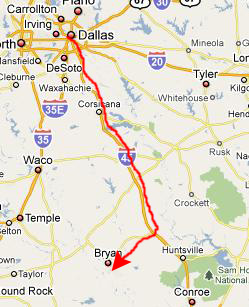 |
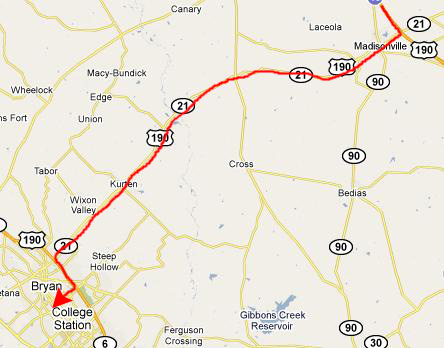
At Madisonville, we took US 190 west towards Bryan, and then took a new bypass south an exit or two to College Station.
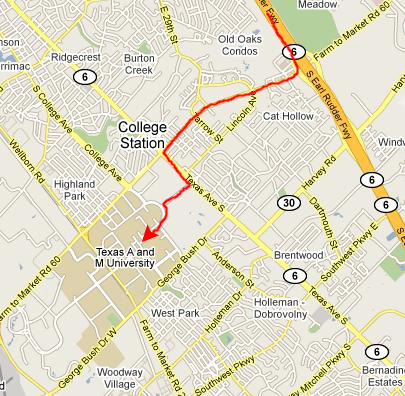 |
When we got onto the campus proper, we found a parking garage that was pretty centrally located, parked the car, and then I turned myself over to Fred for a day-long tour of the campus.
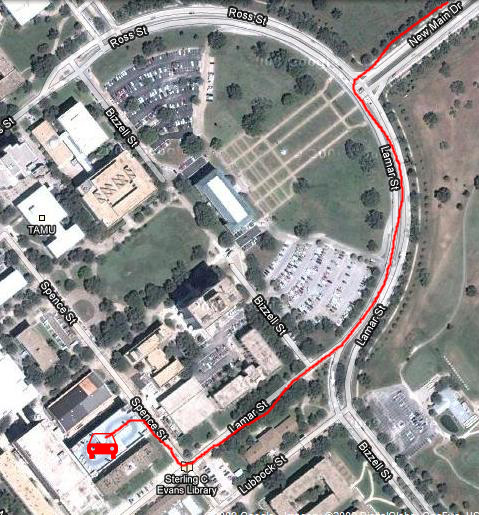
Walking Around Texas A&M University
I think I'll also break this narrative into those same sections, just to make it a little easier to deal with. So let's get started.
Parking Garage to Rudder Tower
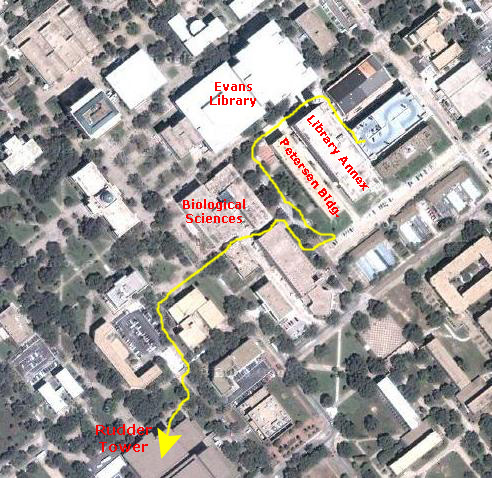 |
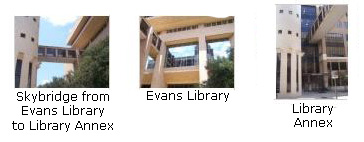
|
Next we walked south alongside the Petersen Building where Fred had taken many of his horticulture classes (you can see a picture of Fred at the entry to this building here), and then came to some of the small greenhouse buildings that were across the street to the south. I couldn't resist taking a picture of someone leaning into the front seat of their vehicle to get something; have a look at that picture here.
We walked a bit back north and through a passage south of the Biological Sciences building. This brought us through one of the many plazas that dot the campus, and then past Hart Hall (more on Hart Hall later) and then finally around to the main entrance to the Student Union and Rudder Tower.
Lunch in Rudder Tower
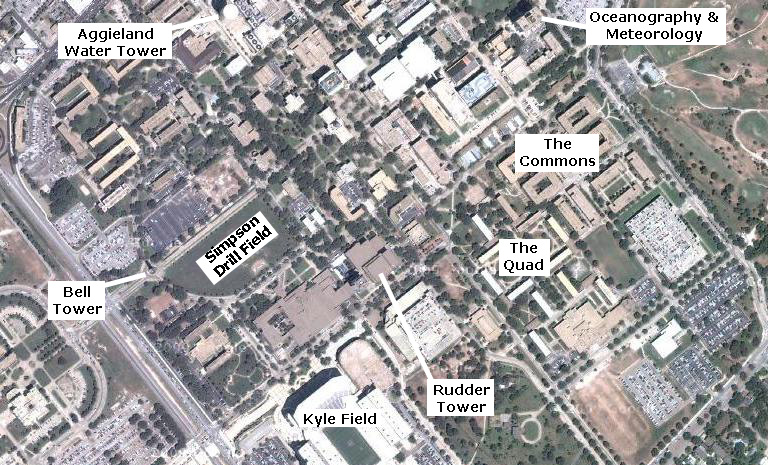 |
One prominent feature on campus that doesn't really show up very well in the broad views that we got from the top of the tower is the Albritton Bell Tower, so I have included a closeup picture of it that Fred took; you can view that picture here.
Labeled thumbnails for the best of the pictures that we took from here in the University Club are below. To look at any of the pictures, just click on its thumbnail:
Rudder Tower to the Academic Building
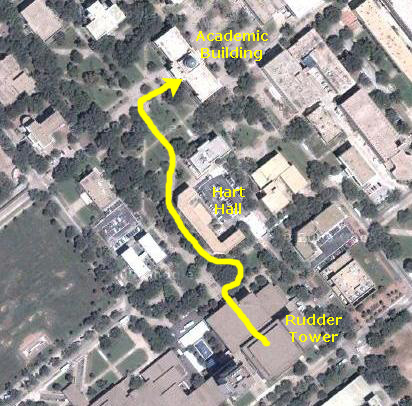 |
Hart Hall was erected on the site of the old Assembly Hall razed in 1929. Named for Laurence J. Hart, a member of the Board of Directors (1909-1924), it was designed as an experiment in student living known as the "ramp system." In this system, rooms were accessed from the outside by a series of stairwells, instead of internal hallways. Each "ramp" (stairway) separated two pairs of rooms which were connected by showers and toilet facilities on each floor. The four-storey building has ten ramps (A through J) and 138 rooms. The corners of the "U" plan are cut at a 45-degree angle. The exterior is very simple, with ornamentation limited to the ramp entrances.
Fred lived in ramp "E" on the second floor. Here is a picture of Fred outside the entrance to ramp "E."
From Hart Hall it was a short walk to the Academic Building. This structure was designed by campus architect Frederick E. Giesecke, (class of 1886) and Samuel E. Gideon, after Old Main was destroyed by fire in 1912. The beaux-arts classical design is a four-storied reinforced concrete structure faced with brick, and crowned with a copper dome. The front facade has four ionic columns supporting the classical pediment. Exterior cast stone belt course, lintels, cornices, columns and panels are made of red granite aggregate made on the construction site. The interior rotunda is framed by twenty‑six doric columns, with a mosaic of the university seal in the floor (donated by the class of 1978), and houses a liberty bell replica presented to the College in 1950.
In front of the building, on the southwest side, is a statue of Laurence Sullivan Ross. "Sul" Ross (1838 – 1898) was the 19th Governor of Texas, a Confederate States Army general during the American Civil War, and a president of the Agricultural and Mechanical College of Texas, now called Texas A&M University. Ross was raised in the Republic of Texas, which was later annexed to the United States. Much of his childhood was spent on the frontier, where his family founded the town of Waco.
When Texas seceded from the United States and joined the Confederacy, Ross joined the Confederate States Army. He participated in 135 battles and skirmishes and became one of the youngest Confederate generals. Following the Civil War, Ross briefly served as sheriff of McLennan County before resigning to participate in the 1875 Texas Constitutional Convention. With the exception of a two-year term as a state senator, Ross spent the next decade focused on his farm and ranch concerns. In 1887, he became the 19th governor of Texas. During his two terms, he oversaw the dedication of the new Texas State Capitol, resolved the Jaybird-Woodpecker War, and became the only Texas governor to call a special session to deal with a treasury surplus. Despite his popularity, Ross refused to run for a third term as governor. Days after leaving office, he became president of the Agricultural and Mechanical College of Texas (now Texas A&M University). He is credited with saving the school from closure, and his tenure saw a large expansion in college facilities and the birth of many school traditions. After his death, the Texas legislature created Sul Ross State University in his honor.
There was one odd thing about the statue- what people left at his feet. Why do students leave cash at the foot of the statue? It's a tradition that goes back many years: it's to bring good luck on exams. Pennies I can understand, but dollar bills? Is that for the guys who really need a LOT of help?
The Academic Building was extremely handsome, and we enjoyed walking around inside for quite some time (not for the least reason than the building was air-conditioned, and today was hot and steamy).
To the Sbisa Dining Hall
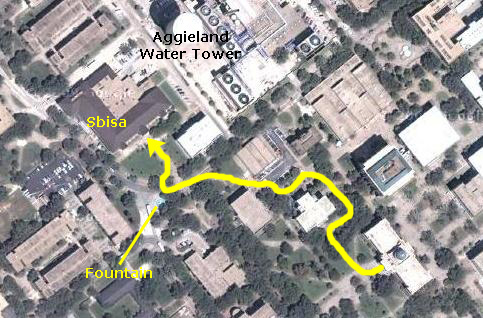 |
We walked across the street to the front of the Sbisa Dining Hall. According to the plaque on the front of the building, Sbisa was built in 1913, although, apparently, no one saw fit to pass that tidbit of information on to the stonemason who carved the medallion above the main entrance. It was designed by the same campus architect, Giesecke, to replace the castle-like 1897 mess hall that burned in 1911. It anchors the north end of Military Walk whose south terminus was Guion Assembly Hall (1918-1971). A one-storey building with a basement, it is constructed in reinforced concrete and brick masonry, with entries marked with doric proticos and pediments. The facade has brick pilasters alternating with arched wood windows and doors. A hipped roof was added during th erenovations and restorations of 1988-2001. The building is named for Bernard Sbisa, who was the "supervisor of [the] subsistence department" for the college from 1879 to 1926.
Inside, the building is thoroughly modern, with a huge eating area adjacent to the restaurant-like serving area called "The Market." Off to the side at the entry to the serving area was a bulletin board that held such items as the daily menu and food prices and various announcements, such as this poster advertising First Yell, which was started by the Yell Leaders (I guess Aggies don't "cheer," but "yell" instead) in 1999 as a way of welcoming all Aggies, current and former students, back to campus to begin a new school year. First Yell occurs on the weekend of the first home football game and includes several different events. Anyway, if you haven't looked at the daily menu or the First Yell poster, you might want to do so now, and then consider the level of academic achievement that has been reached by Texas A&M. They don't tell Aggie jokes for nothing, apparently.
To the Albritton Bell Tower
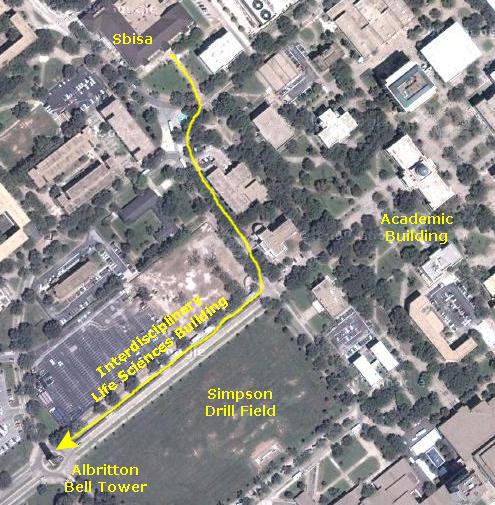 |
Outside, on Simpson Field, some students were playing with a frisbee; see if you can find it in the picture. On the opposite side of the field we could see Kyle Field- the football stadium here at Texas A&M.
We continued on along the front of the Environmental Life Sciences building to reach the Albritton Bell Tower, where we stopped to take a number of pictures. On the far side (southwest side) of it, Fred got a good view looking back through Albritton Tower to the Academic Building. We also took a couple of pictures at the base of the tower building, one of the tower dedication and another of the tower's purpose.
Kyle Field and the Alumni Center
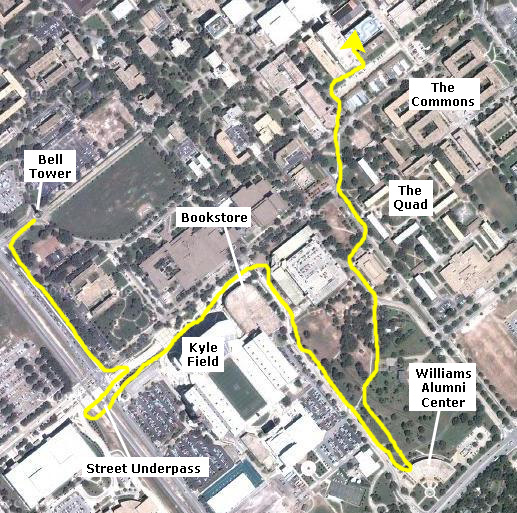 |
Just past Kyle Field, Fred stopped into the campus bookstore to pick up a couple of Texas A&M shirts and a cap for himself. Then, at the next street, we turned and walked southeast to the building housing the Association of Former Students, which was a brand-new building that Fred wanted to see. Shortly after we reached it, a thundershower came along, and we waited it out on the portico of the building.
Finally, we turned and walked back through Spence Park, where the President's house is located, towards Rudder Tower where we had eaten lunch. From there we walked past The Quad and a neat fountain at The Commons before we were back at the parking structure and our car.
I enjoyed very much walking around the Texas A&M campus, but then it was all new to me. A lot of it seemed to be new to Fred as well; after all, he graduated from here thirty years ago, and a lot has changed since then. Texas A&M is a heck of a lot bigger than Davidson, althouth Davidson is an older school. And so there is lots to see here. And, apparently, there are a lot of wealthy alumni who don't mind shelling out for some sizeable donations.
I assume that Fred enjoyed Old Home Week at his alma mater as well, and except for the one shower, we had a nice day for our walkabout.
It was late in the afternoon, so we went to find the Knight's Inn in downtown College Station, checked in, relaxed for a while, and then went out for some supper (and a visit to a new Baskin Robbins).
A Visit to Washington-on-the-Brazos
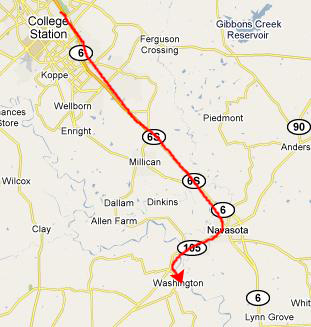 |
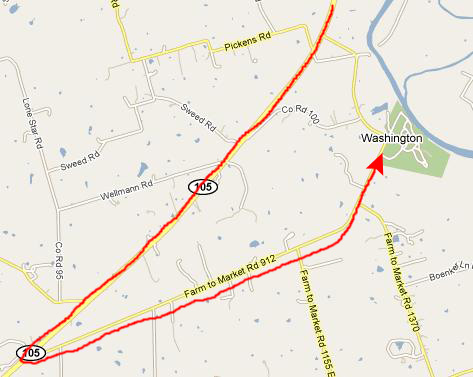
This picturesque park is located on the Brazos River, Washington was the site of the 1836 General Convention which would decide the fate of Texas. Washington-on-the-Brazos State Historic Site is revered as the site of the signing of the Texas Declaration of Independence on March 2, 1836. Washington remained a town of some prominence in early Texas until the eve of the Civil War. The park encompasses the site of the historic town (1836). Washington was the first county seat of Washington County in 1836, the capitol of Texas from 1842 to 1845, and the home of the last president of the Republic of Texas, Anson Jones. Washington-on-the-Brazos State Historic Site, the seat of Texas Independence, is the center each year for the Texas Independence Day Celebration, under the direction of the Washington-on-the-Brazos State Park Association.
Washington-on-the-Brazos in Washington County consists of 293.1 acres. The land was acquired by deed from private owners in 1916. It was transferred to the State Parks Board from the State Board of Control by the Legislature in 1949. Then in 1976 and 1996, more land was acquired by deed from private owners.
Today the park is maintained by Texas Parks and Wildlife. The Washington-on-the-Brazos State Park Association assists the park and the Star of the Republic Museum in this effort. The museum's administration falls under the jurisdiction of Blinn College in Brenham.
Barrington Living History Farm, home of Anson Jones, last President of the Republic of Texas. Handcrafted reproduction log buildings and cropland demonstrate the working of a Brazos Valley farm, circa 1850. Interpreters in period costume work the farm as it was done long ago.
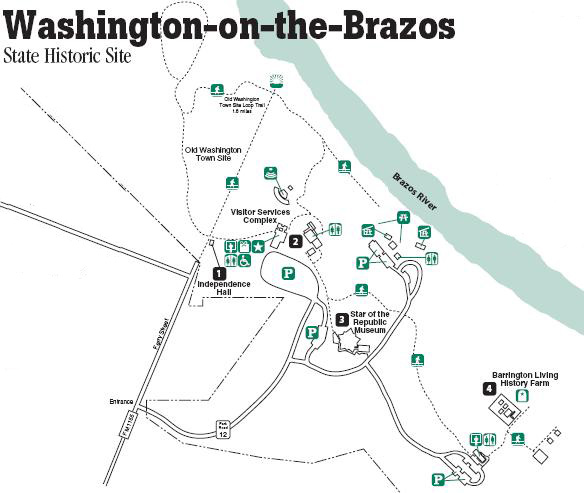 |
Next, we walked out the back of the Vistor Center and down the short path to Independence Hall, the building in which the Independence from Mexico documents were drawn up and the first Constitution for the Republic of Texas was hammered out. Along the path to the building itself, there were two explanatory signs. The first describes the Birthplace of Texas and you should take a look at it. The other describes the building itself, so take a look at it and read about Independence Hall.
We took a few more pictures here at Independence Hall, and you can have a look at them if you click on the thumbnail images below:
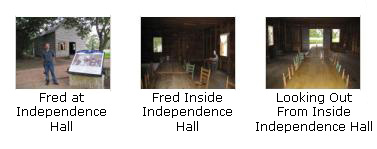
|
Our next stop was the Star of the Republic Museum which was just a short drive to another parking area from the Visitor Services Complex. Outside the museum there was an interesting seating area that had a huge metal lone star over the bench seat. There was also an historical marker dedicated to Andrew Robinson Sr., one of Texas' earliest settlers and the owner of the land on which the park now sits. You can read that marker here.
We went on into the museum, and the lady at the desk examined our admissions that we'd bought earlier, then ushered us on into the museum. Just inside the entry, I made a movie of this first entry into the museum, and you can watch that movie using the player below:
|
Just after we entered the Star of the Republic Museum, I made a movie that pans from the entry desk on into the first floor exhibits. |
We spent quite a bit of time in the museum, and I won't try to describe all the interesting exhibits and artifacts that we saw.
|
To view the slideshow, just click on the image at left and I will open the slideshow in a new window. In the slideshow, you can use the little arrows in the lower corners of each image to move from one to the next, and the index numbers in the upper left of each image will tell you where you are in the series. When you are finished looking at the pictures, just close the popup window.
I took one other movie inside the museum, of the mural paintings along the ramp to the second floor, and you can watch that movie using the player below:
|
There is a long ramp that ascends from the first to the second floor of the museum. Along the ramp is a timeline of Texas history and a series of mural paintings that I tried to capture in this movie. |
For our third thing to do here at Washington-on-the-Brazos, we were going to go over to the Barrington Living History Farm, but the weather got in the way. Not that it was raining or anything, but there had been some lightning, and we were told at the Star of the Republic Museum that when this happened, they closed the Farm so as not to endanger the park personnel who were working outside there. So all we could do was take a picture of the farm off in the distance.
Then we headed off towards Brenham and a stop at the Antique Rose Emporium.
A Visit to The Antique Rose Emporium
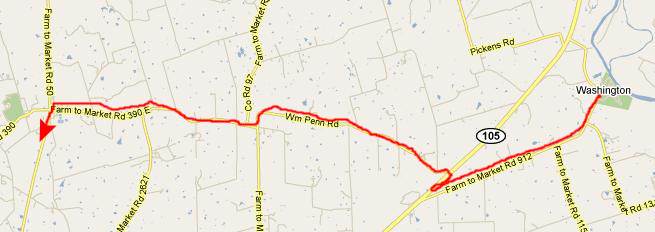 |
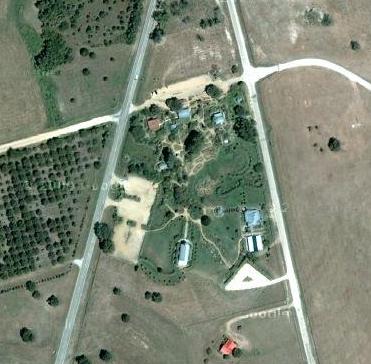 |
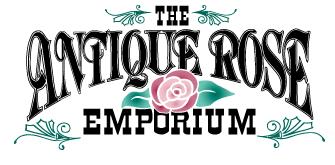
The Antique Rose Emporium is owned by Michael Shoup, who, like many folks, got "hooked" on roses early. As he says on their web site, a rose called 'Mermaid' first got him involved with antique roses in the late seventies, and his fascination with and unbounded appreciation for them has been growing ever since. He didn't start out as a rose lover; with his Master's degree in horticulture in hand, he started in the nursery business in 1976 as a grower of woody ornamentals for the landscape industry. But he soon lost interest in the overused and, for this area, "exotic" plants he was working with (ligustrum, pittosporum, etc.) and began to look for plants native to Texas that might fill the same niche.
On their forays to hunt native plants, his staff (which numbered two at the time) and he also started finding everblooming roses surviving without any apparent care in rather desolate surroundings. This was an enigma to them, for he had never thought of roses as something that could endure the notorious extremes of the Texas climate without a gardener's care. 'Mermaid' opened his eyes. In 1982, while taking an unaccustomerd route back to the nursery after a delivery, one of his co-workers chanced upon a huge rose covering a chain-link fence. He made an unauthorized "rustle," brought back flowers and cuttings, and urged Shoup to go see it. It was surviving, indeed, performing spectacularly, in a completely neglected setting, and Shoup's first thought was that there must be a landscape niche for such a specimen. A rosarian identified it for him, but he could not find 'Mermaid' anywhere in commerce. Soon, it and the other survivors he stumbled across over the next couple of years became the foundation of the Antique Rose Emporium.
It wasn't until 1984 that he discovered that an organized group of the Rose Rustlers existed in this part of Texas. Joining the rustlers opened up a whole world of new varieties. He went out on rustles, swapped "found" roses and talked a lot about what would and would not grow. he began to think of old roses in terms of classes and to expand his collection by seeking out more varieties in the classes he knew offered proven survivors.
At the nursery they gave their finds household names like "Old Gay Hill China" (for the town where they found it) or "Highway 290 Pink Buttons" (found on Highway 290 outside of Houston) to help them remember where they found them. They got help from other rosarians, botanical gardens and literature in their struggle to identify the found roses. Many of them had once been in commerce, in some cases as many as 150 years ago, but only a few still were. As their collection grew, they created a catalog to publicize these great roses that survive in Texas and provide an alternative to ordinary nursery shrubs. Those were their initial criteria: survival and usefulness. Then they realized that old roses are far more wonderful than that. They have delightful fragrance, are resistant to pests and disease and exhibit a splendid diversity of form. Yes, and they flower, too. These roses fit to a T the niche Shoup had originally had in mind for Texas native plants.
Public response to our offerings was growing so fast that it was decided to create a display garden to show off the collection in its best light and to try to get visitors hooked on the virtures of old roses. Shoup and his crew started the display garden in 1985 with a cottage garden and a small formal planting. The garden has grown considerably. They've combined Texas native plants with roses much as a pioneer gardener might have done here in the 1850s (but on a much larger scale.)
When we got the gardens, we parked and I wandered around while Fred searched for some roses he'd been wanting to get. After a time, he checked out with his purchases- three or four new roses for his own collection. Our stop at the Emporium was a nice interlude in the day, but now we had to get on to San Antonio for an event that Ron had planned for this afternoon.
Water 2 Wine in San Antonio
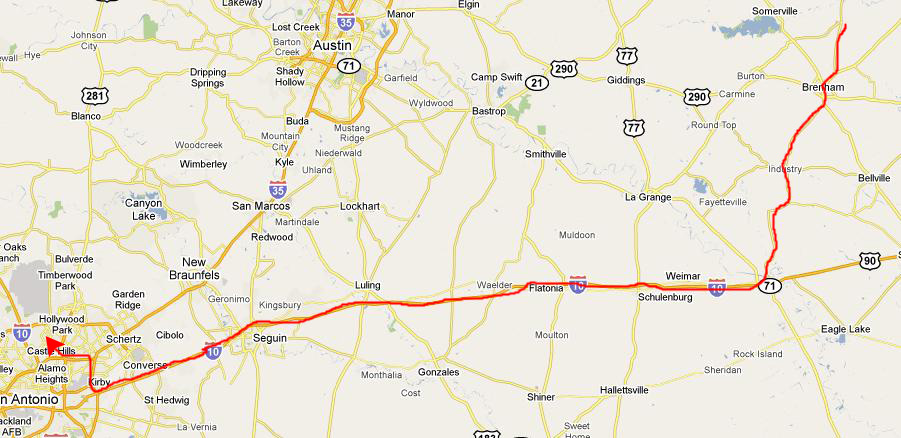
Getting over to Ruckman Haus in San Antonio was pretty easy, if a little boring. We took local highways down through Brenham to Interstate 10, and then took that west to Loop I-410 around San Antonio. Following our GPS, we got onto our familiar route down into the north side of the city on I-35, and from there to San Pedro and up to San Pedro Park and Prudence's Bed and Breakfast.
We arrived, as planned, about three-thirty, and we had a chance to visit a bit with Guy, Nancy and Karl before we all headed off to Water 2 Wine.
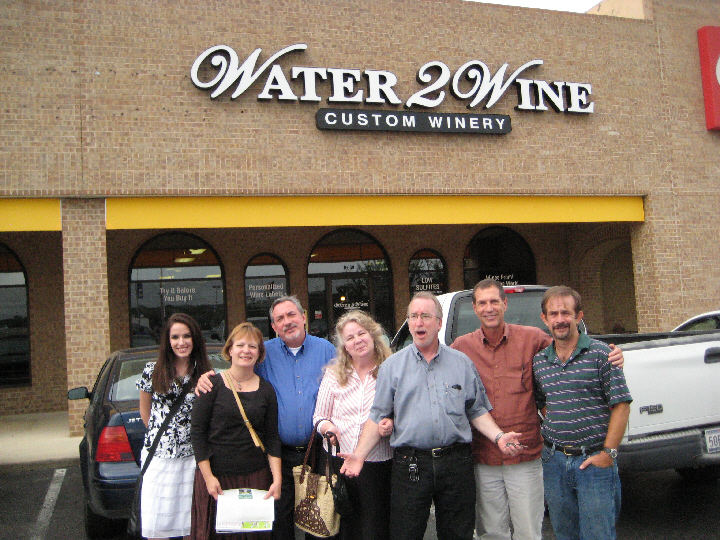 |
When we arrived at the storefront up on Broadway, I had everyone pose for a picture to record the occasion; that's the one that you see at right. Then we went in to bottle some wine.
The process involves a number of steps. First of all, you have to pick the wine you want from the selection available. I think that Ron had arranged for a Merlot, and I understand that this process has to be done ahead of time so that Water 2 Wine can get the wine from a local or far-away winery. My guess is that you can order any grade of wine as well.
Once the wine has arrived at Water 2 Wine, it is held until the patrons come to bottle it. In the bottling process, the first step is to prepare the bottles, which involves (again, you can, apparently, choose your bottle style and color) washing the bottles and then drying them on racks. Next, you take the bottles to the filling machine, which hooks up to the large vessel containing your wine, and fills each bottle with a pre-determined amount of wine. Once the bottles are filled, then there is another pressure machine that inserts the corks.
Once the corks are in, then Water 2 Wine has a special step (I am not sure that regular wineries would do this) in which the bottles are set onto magnetized "coasters." Allowing the bottles to sit on these magnetized coasters has the effect of smoothing the wine, simulating part of the aging process. I don't know how it works, but that was the explanation I got. Once the bottles have rested for a time on these coasters, then you take them to the labeling station, where you put on the wine bottle labels that have been pre-printed on adhesive sheets by Water 2 Wine. I understand that you can bring your own labels as well, but most people don't have the equipment needed to produce really nice-looking labels.
The last step is to take the labeled bottles to a small machine to put on foil cork covers. Then you're done, and you can sit back and admire the finished product, just before you put the wine into cardboard cases that are also supplied by Water 2 Wine.
Everyone took a hand in one or more of the processes I've described above, and throughout the procedure, everyone, including Prudence and Ron, had a chance to enjoy a glass of Ruckman Haus Merlot.
I took a couple of movies while we were here at Water 2 Wine, and you might want to watch them using the players below:
|
One of the first steps in the self-bottling process is the preparation of the bottles, which involves washing them, a process you can see Prudence doing in this short movie. |
While we were all participating in the bottling process, we were sharing glasses of wine and chatting, and this movie is of some of this conversation. |
|
To view the slideshow, just click on the image at left and I will open the slideshow in a new window. In the slideshow, you can use the little arrows in the lower corners of each image to move from one to the next, and the index numbers in the upper left of each image will tell you where you are in the series. When you are finished looking at the pictures, just close the popup window.
Prudence's Birthday Dinner

|
I took one movie at the restaurant, and you can watch that movie with the player below:
|
Just to introduce everyone who was present at Prudence's birthday dinner at Bistro Vatel, I made a movie panning around the table and introducing all the celebrants. |
After dinner, we went back to Ruckman Haus for dessert. Ron had given Prudence a gift of jewelry, and Fred snapped a picture of Prudence opening her gift. Robin had created an "Ace of Cakes" moment with a cake made of fruit, cake and chocolate-covered oriental noodles in a bird's nest shape. And it was really, really good. Here are Nancy and Robin cutting the cake. Prudence had also received flowers from Fred and Nancy, and you can see those arrangements here and here.
Prudence's birthday was very, very enjoyable, and I am glad that we attended.
Around San Antonio
For lunch we went to the 410 Diner where Fred also took a picture of Guy, Ron and myself outside the restaurant. We had a pleasant lunch, and then Guy Fred and I said goodbye to Prudence, Ron, Nancy and Karl, we took Guy to the airport and then headed off for home ourselves.
You can use the links below to go to another album page.
 |
September 8, 2009: A Visit to the Dallas Arboretum with Guy |
 |
August 23, 2009: Marco Antonio Solis Concert in Dallas |
 |
Return to Index for 2009 |